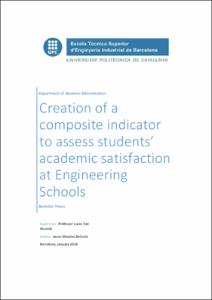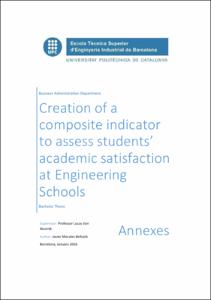Mostra el registre d'ítem simple
Creation of a composite indicator to assess students’ academic satisfaction at Engineering Schools
| dc.contributor | Van Wunnik, Lucas Philippe |
| dc.contributor.author | Morales Bellsolà, Javier |
| dc.contributor.other | Universitat Politècnica de Catalunya. Departament d'Organització d'Empreses |
| dc.date.accessioned | 2016-10-13T18:35:38Z |
| dc.date.available | 2016-10-13T18:35:38Z |
| dc.date.issued | 2016-01 |
| dc.identifier.uri | http://hdl.handle.net/2117/90773 |
| dc.description.abstract | Universities have traditionally responded to two main functions: teaching and research. Universities provide training for high-level jobs and increase the body of theoretical knowledge as well as their possible applications through research. Competitiveness in the academic world has led to the upcoming of many different University tables that order Universities’ according to their academic performance using various combinations of different factors. However, such tables do not put emphasis on teaching quality and are mostly based in objective (though arguable) indicators of Universities’ research performance. In the opinion of the author current league tables can be misleading and confusing for students who use tables to choose a University for their Studies and even for Universities themselves who might be compelled to adopt policies to contempt leagues tables instead of focusing on long term policies aimed to improve both their research and their teaching quality. This document presents the process of creation of an alternative composite indicator which will serve to assess academic performance at Higher Education Institutions in Engineering-related fields. A composite indicator is formed when individual indicators are compiled into a single index, on the basis of an underlying model of the multi-dimensional concept that is being measured. Such multi-dimensional concept to be measured is in this case academic performance understood as the ability of a university to contenting the expectations, enhancing the capacities and providing the tools students consider to be relevant in their process of being transformed from high school students to competent and ready professionals to enter in the labor force as engineers. As a result of such considerations this composite indicator will be focused rather on University as a training and learning institution and not so much as an engine of knowledge creation. The composite indicator created will be put into practice to assess academic performance at four Engineering Schools (Escola Tècnica Superior d’Enginyeria Industrial de Barcelona (Spain), Facoltà d’Ingegneria di l’Università di Roma Tor Vergata (Italy), Facoltà d’Ingegneria di Roma La Sapienza (Italy) and Delft Technical University (Netherlands) to guarantee its applicability in practice. |
| dc.language.iso | eng |
| dc.publisher | Universitat Politècnica de Catalunya |
| dc.rights | Attribution-NonCommercial-NoDerivs 3.0 Spain |
| dc.rights.uri | http://creativecommons.org/licenses/by-nc-nd/3.0/es/ |
| dc.subject | Àrees temàtiques de la UPC::Matemàtiques i estadística |
| dc.subject.lcsh | Education, Higher -- Avaluation -- Statistical methods |
| dc.subject.lcsh | Educational indicators |
| dc.subject.lcsh | Educational statistics |
| dc.title | Creation of a composite indicator to assess students’ academic satisfaction at Engineering Schools |
| dc.type | Bachelor thesis |
| dc.subject.lemac | Ensenyament universitari -- Avaluació -- Mètodes estadístics |
| dc.subject.lemac | Indicadors educatius |
| dc.subject.lemac | Estadística educativa |
| dc.rights.access | Open Access |
| dc.audience.educationlevel | Grau |
| dc.audience.mediator | Escola Tècnica Superior d'Enginyeria Industrial de Barcelona |
| dc.audience.degree | GRAU EN ENGINYERIA EN TECNOLOGIES INDUSTRIALS (Pla 2010) |
| dc.contributor.covenantee | Escola Tècnica Superior d'Enginyeria Industrial de Barcelona |
| dc.contributor.covenantee | Università degli studi di Roma Tor Vergata |
| dc.contributor.covenantee | Università degli studi di Roma "La Sapienza" |
| dc.contributor.covenantee | Technische Universiteit Delft |



